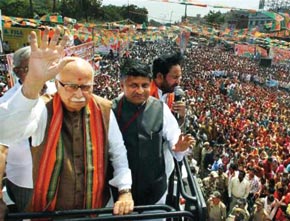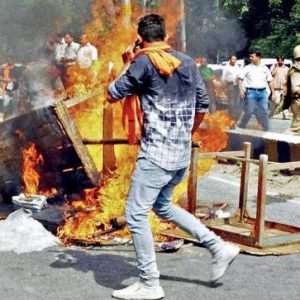“It is not madness; not lunacy. It is the creeping iron in the soul.”
In December 1992, India was shaken awake by the news of 150,000 Hindu nationalists ruthlessly tearing down a mosque built in the 16th Century- Babri Masjid (Babri Mosque)- in order to build a temple on the disputed land. Secular segments of the Indian population received a wake-up call. India still wasn’t free of religious antagonisms.
The year 1992 ended with a reflection of India many hadn’t seen since 1947. The event proved that majoritarian politics, a negligence for the rule of law and empowered religious fundamentalist groups were slowly thawing away at Indian democracy. Similar sentiments exist today, as religious intolerance and political tensions run high. This is greatly due to the Hindu nationalist tendencies of the current Prime Minister Narendra Modi’s party-the Bharatiya Janta Party (BJP). In March 2018, a Supreme Court case will reopen the issue of the demolition and finally put to rest the epochal debate of who the disputed land belongs to. However, despite the decision, the case will trigger the further deterioration of secularism in India. Violence is bound to occur as communities will be probed to act by manipulative politicians who have invoked national myths that divide them along religious lines.
1992: The Babri Masjid Demolition
But first, we must probe into the issue of the Babri Masjid as a lens for understanding the larger structural underpinnings of the religious acrimony unfolding across India. Babri Masjid was built in the holy town of Ayodhya in the state Uttar Pradesh (UP) in the 16th Century by Muslim Emperor Babur of the Mughal dynasty. However, conspiracies arose amongst Hindus that the mosque was built on the birthplace (Ramjanmabhoomi) of the Hindu god Lord Rama. Hindu religious scholars believe that the Mughals looted and burnt down the temple and then erected the Babri Masjid. Parables about Lord Rama highlight the triumph of good over the forces of evil. However, in 1992, Hindu nationalists took this allegory and transformed it into an attack on Muslims and their history within India. The demolition was retribution for the supposed corruption and exploitation of Hindu culture by Muslim conquerors.

Source: Indian Express
A disagreement on whether a temple ever existed before the mosque and whether this was really the birthplace of Lord Rama took a political turn. It transformed through political mobilization and a zealous religious commitment into a full blown attack on Islam in South Asia. Then BJP leader, L.K. Advani strategically mobilized his followers on a religious pilgrimage to the site, to rally up support for rebuilding the temple. The scene changed from a police-controlled rally to all out display of Hindu rage towards this reminder of their historical subjugation. The demolition of the mosque by Hindu nationalist volunteers took place rapidly. People used their bare hands to tear down the controversial structure. What followed were months of fierce riots and agonizing violence across the country between Hindus and Muslims. This was yet another incarnation of South Asia’s long history of communal violence- one which traces back to the creation of India and Pakistan in 1947. Cities such as Mumbai- once a glimmer of progress and modernity- plunged into chaos as religious fervor overtook urban dwellers. An estimated 2,000 people lost their lives during these clashes.
Furthermore, the demolition of Babri Masjid exists in the broader context of saffronisation or recharacterization of Indian history through a Hindu lens. With seats, the BJP has brought an assault on the concepts of fact and truth. They have fueled conspiracies and even promised voters the demolition of UNESCO World Heritage site- the Taj Mahal.
Votes! Votes! Votes!
The demolition of the mosque in 1992 bolstered the Hindu chauvinist imagination and continues to do so today. The early 90s marked a period of high communal tensions that were instigated in part by the harmful rhetoric of revenge and justice for hundreds of years of Muslim rule in India. The BJP had included the demolition of the mosque as a part of their political agenda in 1989. The BJP’s success in the 1992 general elections can be credited greatly to their invocation of Hindutva– or Hindu hegemony. This link between elections and displays of Hindu nationalism is one we need to be vigilant of.
If today, the site were to be granted to the Hindu contenders, it will be a historic deliverance of a promise on behalf of the BJP. This will bolster the position of the BJP, which is facing dwindling support as they lead up to the 2019 general elections. This is true for even Modi’s home-state Gujarat where recent elections showed a significant decrease in the support of the BJP among rural communities. We can expect Modi’s party to once again employ techniques to polarize Hindus and Muslims to get the votes they need.

Source: India Today
Recent communal riots in the Kasganj town of Uttar Pradesh are an example of this. The town had never experienced communal clashes except for post-Babri Masjid wave of violence. Yet, on January 26th 2018, a riot broke out between Hindus and Muslims. Hindu nationalist activists interrupted a Muslim flag-hoisting ceremony for Indian Independence Day. A fight escalated to a full scale riot. One Hindu man was killed. What is important about this case is how the BJP used the tense situation to further their political agenda. Elaborate speeches were made, the death was deemed a martyrdom and a promise of retribution was made. This was a clear attempt to antagonize Muslims and unite Hindus to vote in favour of the BJP. Riots have become the hunting ground for BJP politicians.
Moreover, the location of the disputed land is indicative of the precarious situation. The ancient city of Ayodhya lies in Uttar Pradesh, India’s most populous state. Incidents of communal violence in U.P. have risen by 28% between 2014 and 2017. Conflict between the Hindu and Muslim communities of U.P. is a reflection of the diet of Hindu nationalist propaganda they are fed. The current Chief Minister of the state of U.P. is Yogi Adityanath, a Hindu monk turned politician. He has had 20,000 cases filed against him in the state, relating to the incitement of anti-Muslim violence in his demonstrations. His open support for the illegal demolition in 1992 is alarming. What complicates matters more is the high incidence of police complicity in communal clashes in the state. If violence and destruction by nationalist volunteers were to ensue today- we best believe that the police and state government will not act effectively to ensure law and order, as they failed to do in 1992.
The Verdict?

Source: Outlook India
The issue of faith-motivated violence is one that is so deeply rooted in Indian history, society and politics. The future, despite the verdict, looks bleak. Considering that the original compromise to share the land was rejected by all parties, total possession of the land is the delusional goal. On one hand, if the Court were to give the land to the Muslim contenders, any rational observer would predict an eruption of a series of terribly violent communal clashes. Emboldened by Modi’s vision of India, a forceful retribution like that of 1992 is bound to occur. And similarly to 1992, law enforcement corrupted by powerful political influencers of the Hindutva movement will retreat and watch as communities are ravaged and burned to ruins.
On the flip side, however, is an even bleaker image of what some are beginning to recognise as the true colours of India’s social fabric. If the land were to be given to the Hindu nationalist contenders, it will be a reversal of all the progress towards creating a secular Indian state. This will confirm the biases of the Indian government and judicial system towards majoritarian rule, them acting in the interests of a dangerous nationalism embedded in hyper-masculinity and religious hatred. It will further the movement towards a Hindu state and diminish the little representation and power held by the Muslim minority. And what will be next? A complete reconceptualization of history and the truth? Parables will be twisted into supernatural realities to invoke fear and compliance which will be used to serve the interests of the upper echelons of Hindu society.
It has been 70 years since the brutal Partition of India and Pakistan and 25 years since the demolition of the Babri Masjid. The deep wounds of communal violence and distrust have been reopened for yet another generation to experience. In a time when development and modernity have inched India to where it stands today, a single recreation of one of the most painful displays of hatred can catapult India back into social catastrophe.
Featured Image Source: Sound Vision






Be First to Comment